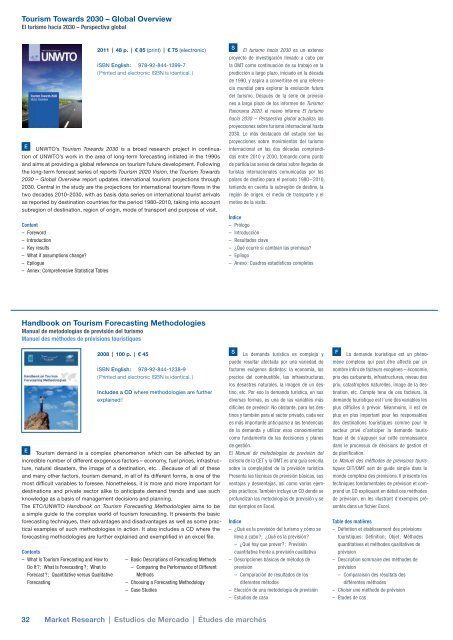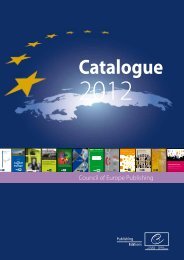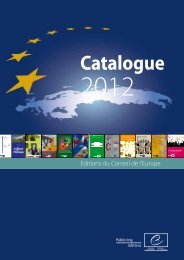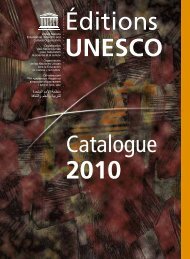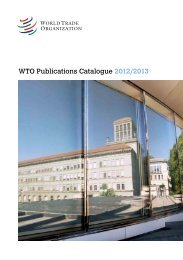UNWTO 2013 Edition - Organización Mundial del Turismo
UNWTO 2013 Edition - Organización Mundial del Turismo
UNWTO 2013 Edition - Organización Mundial del Turismo
Create successful ePaper yourself
Turn your PDF publications into a flip-book with our unique Google optimized e-Paper software.
Tourism Towards 2030 – Global OverviewEl turismo hacia 2030 – Perspectiva globalContent– Foreword– Introduction– Key results– What if assumptions change?– Epilogue– Annex : Comprehensive Statistical Tables2011 | 48 p. | € 85 (print) | € 75 (electronic)ISBN English : 978-92-844-1399-7( Printed and electronic ISBN is identical. )E<strong>UNWTO</strong>’s Tourism Towards 2030 is a broad research project in continuationof <strong>UNWTO</strong>’s work in the area of long-term forecasting initiated in the 1990sand aims at providing a global reference on tourism future development. Followingthe long-term forecast series of reports Tourism 2020 Vision, the Tourism Towards2030 – Global Overview report updates international tourism projections through2030. Central in the study are the projections for international tourism flows in thetwo decades 2010–2030, with as basis data series on international tourist arrivalsas reported by destination countries for the period 1980–2010, taking into accountsubregion of destination, region of origin, mode of transport and purpose of visit.SEl turismo hacia 2030 es un extensoproyecto de investigación llevado a cabo porla OMT como continuación de su trabajo en lapredicción a largo plazo, iniciado en la décadade 1990, y aspira a convertirse en una referenciamundial para explorar la evolución futura<strong>del</strong> turismo. Después de la serie de previsionesa largo plazo de los informes de <strong>Turismo</strong>:Panorama 2020, el nuevo informe El turismohacia 2030 – Perspectiva global actualiza lasproyecciones sobre turismo internacional hasta2030. Lo más destacado <strong>del</strong> estudio son lasproyecciones sobre movimientos <strong>del</strong> turismointernacional en las dos décadas comprendidasentre 2010 y 2030, tomando como puntode partida las series de datos sobre llegadas deturistas internacionales comunicadas por lospaíses de destino para el periodo 1980 – 2010,teniendo en cuenta la subregión de destino, laregión de origen, el medio de transporte y elmotivo de la visita.Índice– Prólogo– Introducción– Resultados clave– ¿Qué ocurre si cambian las premisas?– Epílogo– Anexo : Cuadros estadísticos completosHandbook on Tourism Forecasting MethodologiesManual de metodologías de previsión <strong>del</strong> turismoManuel des méthodes de prévisions touristiquesContents– What Is Tourism Forecasting and How toDo It ? ; What Is Forecasting ? ; What toForecast ? ; Quantitative versus QualitativeForecasting2008 | 100 p. | € 45ISBN English : 978-92-844-1238-9( Printed and electronic ISBN is identical. )Includes a CD where methodologies are furtherexplained !ETourism demand is a complex phenomenon which can be affected by anincredible number of different exogenous factors – economy, fuel prices, infrastructure,natural disasters, the image of a destination, etc. . Because of all of theseand many other factors, tourism demand, in all of its different forms, is one of themost difficult variables to foresee. Nonetheless, it is more and more important fordestinations and private sector alike to anticipate demand trends and use suchknowledge as a basis of management decisions and planning.The ETC/<strong>UNWTO</strong> Handbook on Tourism Forecasting Methodologies aims to bea simple guide to the complex world of tourism forecasting. It presents the basicforecasting techniques, their advantages and disadvantages as well as some practicalexamples of such methodologies in action. It also includes a CD where theforecasting methodologies are further explained and exemplified in an excel file.– Basic Descriptions of Forecasting Methods– Comparing the Performance of DifferentMethods– Choosing a Forecasting Methodology– Case StudiesSLa demanda turística es compleja ypuede resultar afectada por una variedad defactores exógenos distintos : la economía, losprecios <strong>del</strong> combustible, las infraestructuras,los desastres naturales, la imagen de un destino,etc. Por eso la demanda turística, en susdiversas formas, es una de las variables másdifíciles de predecir. No obstante, para los destinosy también para el sector privado, cada vezes más importante anticiparse a las tendenciasde la demanda y utilizar esos conocimientoscomo fundamento de las decisiones y planesde gestión.El Manual de metodologías de previsión <strong>del</strong>turismo de la CET y la OMT es una guía sencillasobre la complejidad de la previsión turística.Presenta las técnicas de previsión básicas, susventajas y desventajas, así como varios ejemplosprácticos. También incluye un CD donde seprofundizan las metodologías de previsión y sedan ejemplos en Excel.Índice– ¿ Qué es la previsión <strong>del</strong> turismo y cómo selleva a cabo ? ; ¿ Qué es la previsión ?– ¿ Qué hay que prever ? ; Previsióncuantitativa frente a previsión cualitativa– Descripciones básicas de métodos deprevisión– Comparación de resultados de losdiferentes métodos– Elección de una metodología de previsión– Estudios de casoFLa demande touristique est un phénomènecomplexe qui peut être affecté par unnombre infi ni de facteurs exogènes – économie,prix des carburants, infrastructures, niveau desprix, catastrophes naturelles, image de la destination,etc. .Compte tenu de ces facteurs, lademande touristique est l’ une des variables lesplus diffi ciles à prévoir. Néanmoins, il est deplus en plus important pour les responsablesdes destinations touristiques comme pour lesecteur privé d’ anticiper la demande touristiqueet de s’appuyer sur cette connaissancedans le processus de décisions de gestion etde planifi cation.Le Manuel des méthodes de prévisions touristiquesCET/OMT sert de guide simple dans lemonde complexe des prévisions. Il présente lestechniques fondamentales de prévision et comprendun CD expliquant en détail ces méthodesde prévision, en les illustrant d’ exemples présentésdans un fi chier Excel.Table des matières– Défi nition et établissement des prévisionstouristiques : Défi nition ; Objet ; Méthodesquantitatives et méthodes qualitatives deprévision– Description sommaire des méthodes deprévision– Comparaison des résultats desdifférentes méthodes– Choisir une méthode de prévision– Études de cas32 Market Research | Estudios de Mercado | Études de marchés


